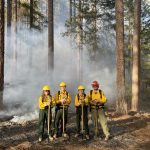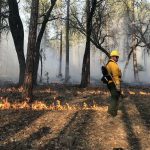 Feather River College Debuts New Bachelor’s Pathway Focused on Reducing Wildfires
Feather River College Debuts New Bachelor’s Pathway Focused on Reducing Wildfires
FRC Ecosystem Restoration & Applied Fire
You can fight fire with fire. In fact, it happens to be one of California’s best weapons against wildfires.
In the woods of Plumas County, forestry and fuel management professionals are upping their efforts to reintroduce prescribed fires to mitigate the spread of these devastating blazes. Projects include these prescribed burns, which help clear the old buildup of dead leaves and invasive vegetation on the forest floor to lower the risk of fast-spreading wildfires. These burns help clear the way for new, native plant species to grow, encouraging biodiversity in the region’s woodlands.
“There is a real need for forest management, and part of that includes prescribed fire skills,” says Feather River College Instructor Bridget Tracy, part of a new bachelor’s degree pathway in Ecosystem Restoration and Applied Fire Management at FRC.
“Our degree is not just about fuels management. It’s a little bit more widely about … restoring these forests and ecosystems in which we live.”
The Plumas National Forest covers over one million acres of land, offering the region a vast and valuable resource to sustainably harvest wood and hydropower. Meanwhile, the woodlands provide ample opportunities for recreational activities and promote local tourism. These forests are as difficult-to-protect as they are vital, with the threat of wildfires virtually ever-present throughout the region.
Take the Dixie Fire that swept through Butte, Plumas, Lassen, Shasta, and Tehama counties in 2021. According to CAL FIRE, the devastating burn swept through 963,309 acres before it was fully contained after 100 days.
“Using fire as a tool to treat fuels in the understory of the forest … is a traditional practice that was done by a lot of indigenous people, and through a lot of the last century, early ranchers and forest managers,” explains Tracy.
“It got out of vogue through a lot of the last century … but we’re increasingly realizing that [it’s] actually an important part of forest management.”
The practice of prescribed fires has been steadily spreading throughout the United States in recent years. Between 2011 and 2019, usage of this prevention method increased nearly 28 percent, according to the 2020 National Prescribed Fire Use Report. These prescribed burns provide countless benefits to the woodlands where they take place, including clearing out invasive plant species, promoting the growth of native plants, shifting valuable soil nutrients, and helping clear out debris that fuels wildfires to rapidly spread.
Due to Feather River College’s remote location, convenience was key to launching a new bachelor’s program and bolstering the local fire prevention workforce. Thanks to Strong Workforce Program funding, FRC can support local faculty in the program and upgrade equipment to give students a more complete experience in their own backyard.
“If you want to really have any upward mobility in the industry, having a bachelor’s degree education gives people a lot more ability to move up, and then longevity in the industry,” reasons the FRC instructor.
Tracy notes that in the past, Forestry students would land seasonal jobs, then find it difficult to climb the career ladder without an advanced degree. The new Ecosystem Restoration and Applied Fire Management program brings along ample career opportunities for students seeking out forest and fuel management positions — especially as the next-closest program exists nearly five hours away.
“As our region faces increasing environmental challenges, there is more of a demand for professionals who can work to restore our ecosystems and manage fire risks,” notes Hayden Lampe, instructional assistant in the Environmental Studies Department. “Graduates of this program will be well-prepared to enter a variety of roles in conservation, land management, and environmental services, largely enhancing local employment opportunities and contributing to the resilience of our natural landscapes in Plumas County.” 
Students like Johnathan Morgan Bruce are helping the effort get off the ground: Once he completes his last two years in the new bachelor’s degree program, Bruce is setting his sights on a full-fledged fire prevention career.
“My career goal after completing the program is to work as a fire ecologist, developing and implementing prescribed burn plans that enhance ecosystem health, reduce wildlife risks, and promote biodiversity,” he says.
Bruce’s ideal gig falls under the category of Forest Fire Inspectors and Prevention Specialists, a position currently commanding an average annual salary of nearly $90,000 in California, according to the Bureau of Labor Statistics. His cohort includes around 10 Ecosystem Restoration and Applied Fire Management students who have completed the first two years of the bachelor’s degree pathway. This fall, the students will enroll in the upper division courses, putting themselves on course to graduate by 2026.
Bruce says the lower division classes gave him the essential skills in fire behavior analysis, ecological assessment, and fire management techniques. The additional curriculum covers a versatile array of backgrounds in forest management, watershed management, restoration skills, watershed skills, along with plant management and ecosystem management.
“These skills provide a solid foundation for understanding the complexities of fire ecology and effectively applying prescribed fire as a land management tool,” he asserts. “Earning this bachelor’s degree will enable me to make a significant impact in my community by contributing to safer, more resilient landscapes.”
Ultimately, Bruce’s ideal career matches up with the four-year program’s goal: To help the region achieve more education about the necessity of prescribed burns in forest management.
The future forester continues, “I aim to educate the public about the benefits of prescribed burns and collaborate with local agencies to implement sustainable fire management practices.”
With the addition of this new pathway, Tracy is confident that the benefits will spread across the region’s woodlands and workforce. As a new generation of forestry workers begin their careers at FRC, more sustainable practices and fire prevention methods are setting the region up for success.
“Part of our motivation is to really try to open this educational door so that we’re training people with the right skills … not to just do this work for a couple of years, but really have some longevity in this industry,” says the proud educator.
“We’re trying to offer what we believe is a unique and local take on forest management [and] forest restoration needs that we have here.”
Sources:
https://www.fire.ca.gov/incidents/2021/7/13/dixie-fire/
https://www.stateforesters.org/wp-content/uploads/2020/12/2020-Prescribed-Fire-Use-Report.pdf
https://www.onetonline.org/link/localwages/33-2022.00?st=CA
June 2024
 Feather River College Debuts New Bachelor’s Pathway Focused on Reducing Wildfires
Feather River College Debuts New Bachelor’s Pathway Focused on Reducing Wildfires